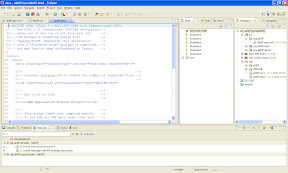This post was stimulated by batch of small problems with settings things up. Not everything is decided already - for example used technologies. I just wanted to make research about available frameworks. In fact I'm mainly Java programmer. But web applications are the future in my eyes. And this is all the time about (X)HTML and JavaScript or if you want about incompatibility between particular browsers. There are always small differences which are driving me mad when I'm trying to center something or move few pixels there or there. Of course I'm not only one who want to develop application logic and not to play with details and differences between FF and IE and Safari and...! And here comes several frameworks which should make this dirty work for you. There are special CSS files or JavaScript libraries which can unify the behavior of browsers. For example I'm quite big fan of
JQuery framework and I wanted to use this technology in aktiff project.
I dig out another framework later during necessary searches for start open source project. I'm talking about
Google Web Toolkit (GWT) which is framework allowing you to write web application's UI in the Java programming language and embedded tools will later parse this code and will create HTML/JavaScript build of client side - with special version for every browser. So no need to be worried about browser differences - guys from Google make it for me already. This is huge thing for me because Java is my favorite environment and it should save so development time. So I'm excited enough to try this technology right now!
And here we are, first complications. I don't have experiences with SVN repositories because in our company we're still using old-fashioned CVS system. Okay, the Eclipse IDE doesn't have SVN support bundled inside by default. No problem - installation in new versions is question of putting correct URL and pressing OK button...
One hour later: No it's not so easy. I really should read instructions around the install URLs. After installation of 3 plg-ins I'm recommending
Subclipse plug-in directly from Tigris. It's more user friendly in my opinion than
Subversive plug-in. Additionaly version for new Eclipse Galileo is in incubation state. (Later in the story: the choice of brand new IDE is not so smart as it looks.)
So this is small tutorial of installation Subclipse plug-in:
Add the
http://subclipse.tigris.org/update_1.6.x site to your installation manager and refresh the content. The everything what is there: SVNKit library, JNA library and whole Subclipse with all optional modules. There is no reason to save disc space on this - as I did in my first tryings. SVN plug-ins need also special drivers and other stuff to work normally. Dependences will be resolved automatically. Accept the license and click Finish button. Restart of Eclipse is required.
Open the SVN Repository Exploring perspective after restart. Open the add resource location wizard in SVN Repositiories view (in toolbar or using context menu) and add google hosting SVN url. But which one? Maybe there were some problems today with Google's SVN or something but their instructions didn't work for me at all:
https://aktiff.googlecode.com/svn/trunk/ aktiff --username [user_name] will cause Bad URL passed to RA layer svn error. So I put there just
https://aktiff.googlecode.com/svn/trunk/ which looks like working.
Second thing to do is Google plug-in for Eclipse which is helping with development of GWT and GAE (Google App Engine) applications. This point cause me another complication. The plug-in is compatible with Eclipse Europa and Ganymede for now. Damn, my experiments with SVN under Eclipse Galileo was worthless. No problem, I downloaded Eclipse Ganymede (version for J2EE programmers of course) and install Subclipse plug-in again (with the same limitations as before). Later the Google plug-in and this is small tutorial to it:
Add
http://dl.google.com/eclipse/plugin/3.4 site to your install manager, refresh and take rather everything again. Accept the license, wait and allow Eclipse to restart itself. The plug-in was successfully installed. I ran the New Web Application wizard from Google and create new project. The structure and basic files were created and I assign this project to SVN repository. Everything went well, but it's strange that i didn't need user name and password when I was committing changes. (On the other hand, during installation and connecting to SVN I was prompted once to provide my user name and password - probably it is remembered somewhere on my machine.)
I took longer than I expected (it's ALWAYS like this) but in the end it works. And I'm glad. Check-outing the project will be much easier for other aktiff participants. Later I will create detailed step-to-step guide for co-programmers in project's wiki.

 It's time to celebrate. Google developers were again very agile and just few days after official release of
It's time to celebrate. Google developers were again very agile and just few days after official release of 

